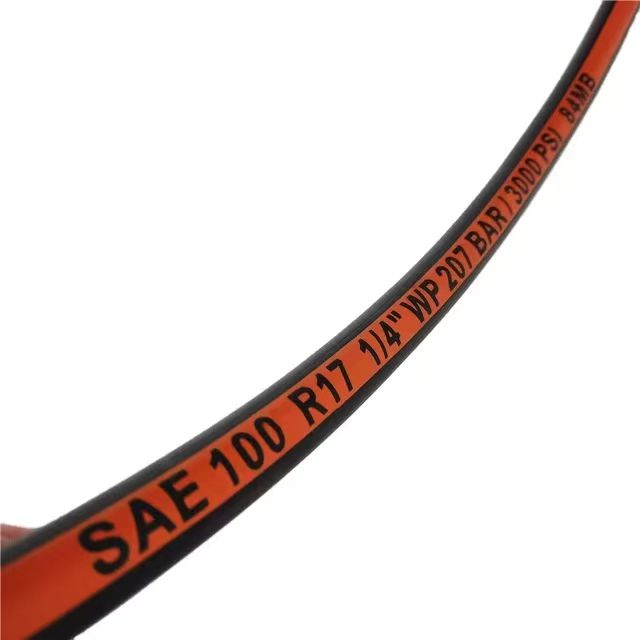335345435
Nov . 09, 2024 17:37 Back to list
Replacing Hydraulic Hoses for Optimal Performance and Reliability in Machinery
Replacing Hydraulic Hoses A Comprehensive Guide
Hydraulic systems are critical components in various machinery and equipment across numerous industries, including construction, manufacturing, and agriculture. At the core of these systems lies the hydraulic hose—a vital component responsible for transferring fluid under pressure. Over time, hydraulic hoses can wear out, leading to leaks, inefficiencies, and potentially dangerous situations. Understanding when and how to replace hydraulic hoses is essential for maintaining the integrity and performance of hydraulic systems.
Understanding Hydraulic Hoses
Hydraulic hoses are designed to withstand high pressures and resist the damaging effects of hydraulic fluids. They are typically constructed from three main components the inner tube, the reinforcement layer, and the outer cover. The inner tube carries the hydraulic fluid, while the reinforcement layer provides strength and flexibility, and the outer cover protects the hose from environmental factors such as heat, abrasion, and chemicals.
Signs that a Hydraulic Hose Needs Replacement
Identifying when a hydraulic hose needs replacement is crucial for preventing system failures. Here are some common signs to look out for
1. Visible Damage Inspect hoses regularly for signs of wear, such as cracks, cuts, bulges, or severe abrasion. Any visible damage can compromise the hose's integrity.
2. Leaking Fluid One of the most straightforward indicators of a failing hydraulic hose is the presence of fluid leakage. If you notice hydraulic fluid pooling or spraying near hoses, it’s time to investigate further.
3. Swelling or Bulging Hoses may swell or bulge due to internal pressure or fluid contamination. This is a clear sign of potential failure.
4. Unusual Noises If your hydraulic system begins to make unusual noises, such as whining or hissing, it could indicate a problem with the hoses or a drop in fluid pressure.
5. Decreased Performance A noticeable drop in equipment performance can often be traced back to faulty hydraulic hoses. If machinery is slower to respond or lacks power, check the hoses.
replacing hydraulic hoses

Steps for Replacing Hydraulic Hoses
Once you've determined that a hydraulic hose needs to be replaced, follow these steps to ensure a proper installation
1. Safety First Before starting any work, ensure all equipment is powered down and the hydraulic system is depressurized. This is critical to avoid accidents and injuries.
2. Remove the Old Hose Loosen the fittings that connect the hose to the hydraulic system using appropriate tools. Be prepared for residual fluid to escape during this process, and have a container ready to catch any spilled hydraulic fluid.
3. Select the Right Replacement Hose It’s vital to choose a replacement hose that matches the specifications of the original. Consider the hose’s diameter, length, pressure rating, and compatibility with the hydraulic fluid.
4. Install the New Hose Carefully attach the new hose to the hydraulic system, ensuring that all fittings are tight and secure. Use proper torque specifications to avoid over-tightening and damaging the fittings.
5. Test the System Once the new hose is installed, gradually re-pressurize the hydraulic system. Check for leaks by visually inspecting the connections and monitoring pressure levels during operation.
6. Regular Maintenance Incorporate regular inspections and maintenance into your routine to catch potential issues early. This proactive approach can extend the life of your hydraulic hoses and overall system.
Conclusion
Replacing hydraulic hoses is a critical aspect of maintaining hydraulic systems. By recognizing the signs of wear and following proper replacement procedures, operators can ensure their machinery runs efficiently and safely. Regular inspections and adherence to best practices not only extend the life of hydraulic hoses but also protect the overall functionality of hydraulic systems, keeping operations running smoothly. Whether you are a seasoned professional or a novice in the field, understanding the importance of hydraulic hoses and their replacement is essential for successful equipment management.
-
SAE 100 R17 Black Smooth Cover Hydraulic Hose
NewsMar.07,2025
-
SAE 100 R17 Black Smooth Cover Hydraulic Hose
NewsMar.07,2025
-
SAE 100 R17 Black Smooth Cover Hydraulic Hose
NewsMar.07,2025
-
SAE 100 R17 Black Smooth Cover Hydraulic Hose
NewsMar.07,2025
-
SAE 100 R17 Black Smooth Cover Hydraulic Hose
NewsMar.07,2025
-
steel wire braided hydraulic hose
NewsMar.07,2025



